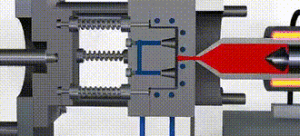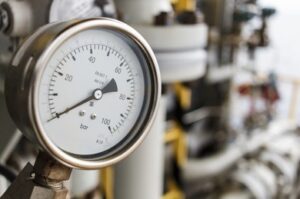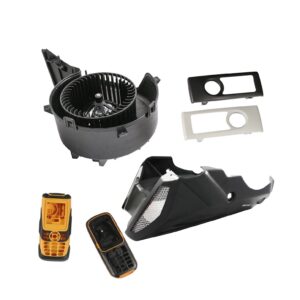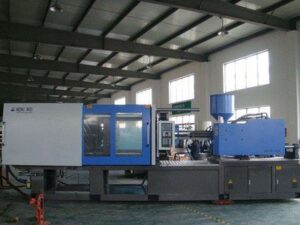When choosing an injection molding machine for your plastic injection molding needs, there are several factors to consider. These include the number of parts you need to produce, the volume of materials you’ll be using, and your budget. There’s also a decision to make about the type of mold or tooling you’ll need. This will impact the materials you’ll need and the type of injection molding machinery you need.
Process
Plastic injection molding machines are machines that use plastic materials to create complex shapes. The material is heated and injected into a mold cavity. The molten plastic then solidifies inside the cavity. Flashes can occur on the edges of the part. Once it has cooled, the part is released from the mold using ejector pins.
The process begins with the plastic part being heated, and the injection molding machine then dispenses the molten plastic. The molten plastic flows into the mold cavity and takes on the shape of a hollow space. The molten plastic gains volume, and most of this volume is contained in the front half of the mold. Sometimes the mold contains multiple cavities.
The plastic injection molding process consists of several steps. The first step involves applying pressure to the molten plastic. This pressure is typically 100 to 150 MPa. It is applied for a few seconds, and then the molten plastic is forced through the mold cavity. The injection pressure should be accurate and controlled, or the molded part may not be perfect.
The next step in the plastic injection molding process involves clamping. A clamping unit pushes two mold halves together so that the plastic can be injected. This process requires time, and the clamping time depends on the size of the mold. Larger machines require more clamping time. If the clamping pressure is too high, the plastic may leak. Similarly, excessive clamping pressure can lead to failures in the mold and equipment. A cracked platen, cracked hydraulic cylinder, and crushed vents are all risks that can occur.
When using a plastic injection molding machine, it is essential to choose the right resin for the part. This is because the resin that is used in the process is crucial to the final product. Understanding the different resin types will help you choose the right resin.
Materials used
Materials used in plastic injection molding machines vary depending on the process used and the complexity of the product. In general, the process produces plastic parts that are highly repeatable and do not degrade over time. This makes injection molding an excellent choice for high-volume manufacturing and brand consistency. The temperatures used in the molding process range from 150 to 350 degrees Celsius.
Injection molding is compatible with a variety of materials, including all thermoplastics and some thermosets. It is also compatible with liquid silicones and can be reinforced with fibers, rubber particles, minerals, and flame retardant agents. To increase stiffness and strength, fiberglass can be added to parts at a 10 or 15% ratio.
LDPE plastics are another popular choice for injection molding. These types are lightweight, durable, and chemically resistant. They can also be reinforced with glass fiber or minerals. Another type of polymer is high density polyethylene (HDPE). It is an excellent workhorse polymer and is used in consumer products. Low density polyethylene (LDPE) is a softer version of HDPE and is also used in consumer products. Lastly, polyvinyl chloride is a heavier grade of plastic than most others but is used in building products.
Some parts may require the addition of glass fibers, fiberglass, and colorants. Injection molding machines can produce plastic parts with an extra layer of color. Standard colors include red, yellow, black, green, and blue. Injection-molded parts may also require surface finishes to give them a cosmetic look or to serve a technical purpose. Surface roughness, for example, can affect the lifespan of sliding parts.
Materials used in plastic injection molding machines are important for the quality of the parts produced. The right mixture of raw materials is the key to creating high-quality parts. The process relies on the proper ratio of raw materials and colorant. The raw materials are then measured and released into a central mixing chamber.

Cycle time
Plastic injection molding machines have several components that determine their cycle time. The machine will usually have a clamping unit and a power source. The mold assembly and injection unit will work together to mold parts. When the parts are ready, they are removed from the mold using a hydraulic ejection system.
The cooling time will depend on the material thickness and the design of the cooling lines inside the mold. The length of the cycle time will also depend on the size of the production. Moreover, the temperature of the cooling fluid is critical. The pump must be powerful enough to move the cooling fluid. However, centralized cooling systems may not be sufficient when multiple moulding machines are installed. The cycle time can also differ between different technicians based on training, experience, and understanding.
Besides the injection process, cooling time is another major component of the molding process. The part’s quality is greatly affected by the rate of cooling. If the cooling process is inefficient, the part may suffer from flow marks and warpage, which can be costly. In the conventional mold system, straight channels are drilled into the mold’s walls to pass cooling fluid through the mold. The cooling fluid exchanges heat with the mold cavity and thus, the part’s temperature is not uniformly distributed.
The chemistry of the plastics used in the mold will influence the cycle time calculation. Certain polymers don’t solidify as quickly as others. This can result in longer mold cavity times.
Design considerations
One of the first things you need to consider when designing a plastic part is the overall shape. You should avoid creating sharp edges or corners. Radii should also be even and smooth. This will minimize the risk of fractures and improve material flow. Then, you should create your part to be a uniform thickness throughout.
Designing your mold should also include the placement of the gate. Gate locations are important because they will affect the flow of plastic. This will ensure that the plastic reaches all areas of the mold before cooling. It is also important to avoid placing the gate near cores or pins. Keeping these in mind, you’ll be able to create the perfect product.
Another important thing to consider is the transitions between different sections. Smooth transitions allow the material to flow evenly inside the mold cavity, avoiding defects and warping. In addition, rounded corners reduce the risk of part-sticking to the mold. Finally, consider the thickness of the ribs. If the ribs are too thick, sink marks will result.
Injection molding machines are a great way to manufacture complicated parts at affordable costs. However, they can also be very expensive if you change mold designs later. That’s why achieving the best possible results is so important. To avoid the most common defects and ensure the highest quality, make sure your mold is designed to be uniform in wall thickness. Any deviation from this will lead to warping of the part as it cools.
Molds should be sized to avoid overhangs and to improve flowability. In addition, it’s important to think about the location of the gate and the spacing between bosses. Molds with narrow gate openings are more expensive to manufacture and will reduce the mold’s lifespan.






